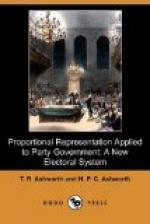If the basis of carrying on the government is to be the wishes of some millions of units, it is evident that they must to a greater or less extent agree in wishing for something. It is equally evident that they cannot all agree in wishing for the same thing at the same time, while if they, or any considerable number of groups, want different things at the same time, the result in so far is anarchy. Government is paralysed, and with the well-known excitability of humanity in groups men begin to confound the importance of the thing wanted with the importance of getting what they want. The clash of contending factions is apt to suggest the clash of arms. The first necessity, therefore, is the formation of large and coherent parties, not merely for the purpose of accomplishing what is desired by the majority of the people, but also for suppressing agitation and social disturbance on behalf of what may be called merely objects of passion or private interest with comparatively small groups, at least until those objects enlist the support of a large minority. (Vol. i., pp. 492, 493.)
+Professor Nanson.+—In Victoria the Hare system is championed by Mr. E.J. Nanson, Professor of Mathematics at Melbourne University. Professor Nanson approaches the subject entirely from a mathematical standpoint, and resolutely refuses to admit the factor of human nature into his calculations. Following Mr. Hare, he is a declared opponent of party government, and “would like to see it pushed further into the background.” Moreover, he regards every step in the process as an end in itself. Thus the act of voting is one end, representation is another, and the rule of the majority a third. Leaving aside for the present, however, the elaborate mathematical devices which are proposed for attaining these supposed ends, let us take only the principles on which they are based. These are laid down as follows:—
(a) The rule of the majority.
(b) The fair
representation of all parties in proportion to their
strength.
(c) Perfect freedom
to every elector to vote exactly as he
pleases.
(d) The emancipation
of the voters from the tyranny of the
political “boss”
or caucus.
(e) The full
value of his vote to each voter without loss or
waste.
The principles involved, we are assured, “must appeal to every democrat, to every Liberal, to every lover of true and just representation.”
As to the first claim, we are willing to grant the rule of the majority, if the words are added “in the interests of minorities.” The second could also be granted if by “all parties” were meant both parties, for there cannot be more than two parties in the true sense of the word. But Professor Nanson proposes such large electorates that any small section, from one-sixth to one-twelfth, can secure independent representation. Notwithstanding




